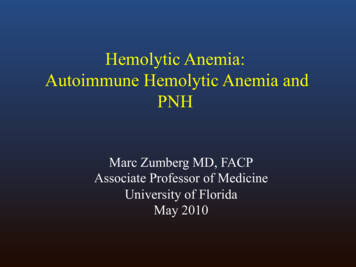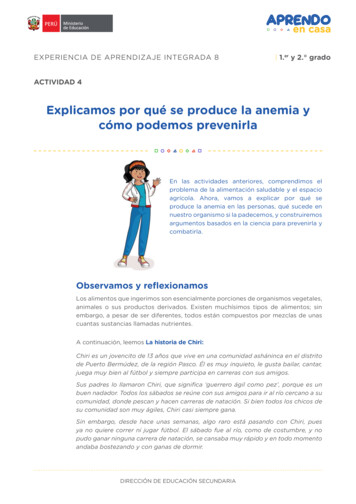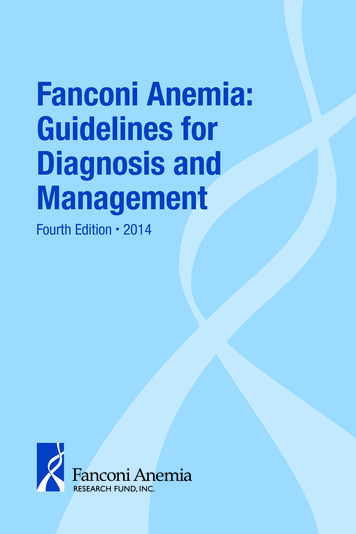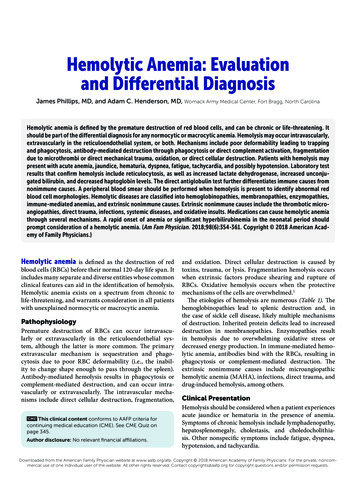
Transcription
Anemia-2:Overview and Select CasesMarc ZumbergAssociate ProfessorDivision of Hematology/Oncology
Initial Laboratory Complete blood count with indices– MCV-indication of RBC size– RDW-indication of RBC size variation Examination of the peripheral blood smear Reticulocyte count-measurement of newlyproduced young rbc’s Stool guiac
Additional Labs Vitamin levels--FE battery, Vit-b12, folateLDH, bilirubin, haptoglobinCoomb’s testHemoglobin electrophoresisSPEPCreatinineTSHurinalysisConsider bone marrow examination
Anemia:Morphology Classification Microcytic (MCV 80 cu microns)– FE def, thalasemia, chronic disease, sideroblasticanemia, lead poisoning Normocytic (MCV 80-100 cu microns)– acute blood loss, chronic disease, hypersplenism, bonemarrow failure, hemolysis Macrocytic– megaloblastic anemia, hemolysis with reticulocytosis,chemo, hypothyroidism, MDS
Anemia-Case 1 Fe deficiency–––––DiagnosisDifferentialIron studiesTreatmentLength of therapy
Case 2 B-12 deficiency–––––Differential diagnosisPathophysiologyDiagnostic entitiesAssociated conditionsTreatment Options
Case XA 53 year-old female complains of fatigue for 3 months.She falls and breaks her left femur.On reviewing her labs the creatinine is 1.3 mg/dl, calcium10.1 mg/dL. Comprehensive metabolic panel isotherwise normalHematocrit is 25%. White blood count and plateletcounts are mildly depressed at 3.9K/mm3 and 147K/mm3
Case X What is the most likely diagnosis? How do you want to proceed with yourevaluation?– What is the next step?– How would you make the definitive diagnosis?
Case X further evaluation Serum protein electrophoresis (SPEP)– M- spike of 4.2 gm/dl Immunofixation (IFE)– IgG lambda noted in serum. Free lambda light chainsin urine Quantitative immunoglobulins– Moderately suppressed levels of IgM (31 mg/dL) andIgA (32 mg/dL). IgG elevated at 3875 mg/dL Skeletal survey– Multiple lytic lesions throughout the skeleton Bone Marrow aspirate and biopsy– Sheets of malignant appearing plasma cells identified
Serum Protein Electrophoresis An M-protein is usually seen as a discrete band onagarose gel electrophoresis in the γ,β,α2 region ofthe densitometry tracing– Immunoglobulins primarily in γ component, but also inβ and α2 region A polyclonal response produces a broad band or abroad-based peak limited to the γ region
Serum Protein Electrophoresis
α1α2βγ* MYELOMA
AlbuminM-spike ing/dL ofproteinα-2α-1βDensity Scan
When to order a SPEP When you suspect multiple myeloma, Waldenstrom’smacroglobulinemia or amyloidosis With unexplained– Weakness, fatigue, anemia, back pain, fractures, hypercalcemia,renal insufficiency– Recurrent infections– Sensorimotor neuropathy, carpel tunnel syndrome, CHF, syncope
Immunofixation (IFE) Proteins are fractioned on electrophoreticstrips– Each lane overlaid with monospecific antiseraagainst IgG, IgA, IgM, and light chains– Immunoglobulins are precipitated by antisera Wash away nonprecipitated proteins– Precipitated proteins are stained
SPEgammaalphaNORMALmukappalambda
When to order IFE To type the paraprotein (M spike) identified on SPEP Further evaluate an equivocal SPEP To search for a low level paraprotein with a negative SPEP– clinical suspicion of a lymphoplasmacytic disorder is high– unexplained symptoms such as neuropathy, renal failure, etc. When searching for Bence-Jones proteinuria In treated myeloma patients with a negative SPEP
Quantitative Immunoglobulins Useful to quantitate– the amount of monoclonal protein– suppression of uninvolved immunoglobulins in amonoclonal disorder– identify a congenital or acquired deficiency state of anindividual immunoglobulin Serum light chain assays are newer and verysensitive technique for measuring serum lightchains– Adjunct or replacement of urine protein electrophoresis
Quantitative Immunoglobulins Albuminα-1 α-2β“M-spike”,“Paraprotein”or “Mcomponent”Note loss of normal “polyclonal”immunoglobulins
Our Patient
Stage III multiple myelomaThe patient is started on systemic chemotherapy and anautologous bone marrow transplant is planned Multiple new and effective agents exist for MM––––Thalidomide or Revlimid and other anti-angiogenic agentsProteosome inhibitors (Velcade)Double autologous transplantMini allogeneic transplant Remains non-curative except possibly for allogeneictransplant
Case 3A woman in her mid thirties has suffered fromepisodes of pleurisy and has been told she may haveSLE.Her prior blood cell counts have been normal. Shenow complains of exertional dyspnea, fatigue andyellowing of her eyes. Physical exam is normalexcept for mild scleral icterus, and moderatesplenomegaly.
Case 3Initial labs reveal:hgb 7.9 gm/dlhct 23.9%wbc 4000 /mm3 with a normal differentialplatelet 138,000 /mm3What other initial labs / values would you liketo see?
Case 3MCV 114 cubic micronsRetic count 14.2% uncorrectedLDH 2343 U/LBilirubin 4.3 mg/dl, .8 direct mg/dlThe peripheral blood smear revealsmacrovalocytes, polychromasia and anoccasional nucleated red blood cell.
Case 3You suspect an autoimmune hemolyticanemia based on her history, PE, labs andsmear.What further tests would you like to order?
Case 3
Case 3Direct Coombs test results are as follows:DAT: Positive 3 IgG: Positive 3 Complement: NegativeWhat type of autoantibody is this?What conditions are typically associated with thistype of antibody?
Case 3You diagnose a warm-antibody hemolytic anemiaand suspect an underlying autoimmune neimmunodeficiencylymphoproliferative drugimmune deficiency
Case 3You decide to avoid blood transfusionbecause of:1.) the difficulties in obtaining cross matchcompatible bloodAND2.) the expected short half life of transfused bloodWhat treatment do you recommend?
Case 3TREATMENT Prednisone Splenectomy Immunosuppressive agents– cytoxan, immuran, cyclosporin Danazol Plasma exchange / immunoadsorption
Case 3You begin her on 60mg Prednisone and shehas a good response. However upon severalattempts at tapering the prednisone she has arelapse with worsening of the hemolyticanemia.As you are concerned about the long term sideeffects of Prednisone you send her for aProcedure.
Case 3She responds well to splenectomy, but stillrequires very low maintenance doses ofPrednisone.Over the years she occasionally requireshigher doses of prednisone when she is ill orhas a lupus flare
Case 4Mrs. P is a previously healthy 32 year-old femalewith no prior medical history. She reports feeling“unwell” for the past month. However in the pastthree days she has experienced fevers, a ‘rash” onher legs, weakness and shortness of breath. She hasbeen to weak to get out of bed the last 24 hours andhas experienced spontaneous nose bleeds.How is this case different from the previous?
Case 4Physical exam reveals an ill appearing female:T 38.6, pulse 122, bp123/54dried blood in the nares, pale conjunctiva,dried mucous membranetachycardia and tachypneapettechia over the lower extremities
Case 4Routine labs include:WBC 1700/mm3Hgb 5.6 gm/dlHct 18.2%Plt 12,000/mm3What important piece of laboratoryinformation is missing from the WBC?
Case 4Differential of the white blood cell countreveals at least 50% of young white cells, thelab thinks are blastsreticulocyte count corrected is 0.4%electrolytes are consistent with dehydrationpotassium and creatinine are slightly elevated
Case 4What would you do next?
Case 4
Case 4
Case 4Hematopathology evaluation revealed AMLsubtype M1 ?Chromosomal studies did not reveal anyabnormalitiesWhat should you do prior to beginningchemotherapy in this patient?
Case 4The patient tolerated induction chemotherapywell and remains in remission 4 months aftercompleting induction and consolidationchemotherapy. Her blood counts have all nownormalized.If she was to relapse what therapy would yourecommend?
Case 5You are referred a pleasant 34 year-oldAfrican American female who has beenknown to have a mild microcytic anemia,which was picked up some years ago on routineblood work. She is entirely asymptomatic. She hasbeen prescribed iron several times over theyears without a response.What data would you like to review?
Case 5Summary labs:––––Hcthgbpltwbc31-34%10.6-11.4 gm/dl232-312K/mm36500-8000/mm3 with a normaldifferential– MCV 72-74 cubic microns– RDW NormalWhat is in your differential diagnosis?
Case 5 FE deficiency anemia– noncompliance, inadequate dosing, incorrectformulation Beta-thalassemiaAlpha-thalassemiaAnemia of chronic inflammation/ diseaseSideroblastic anemiaLeadWhat further laboratory tests would you liketo order?
Case 5 Fe studies are normal Chemistries, liver function tests, thyroidstudies are normal No history of lead exposure You ask to see a peripheral blood smear andone other study. What is it?
Case 5
Figure 3. The patient has the Asian variant of alpha thalassemia trait with a deletion in cis ofboth alpha globin genes on one chromosome 16Schrier, S. ASH Image Bank 2002;2002:100327Copyright 2002 American Society of Hematology. Copyright restrictions may apply.
Case 5You also request a HemoglobinelectrophoresisHgb A 97.5%Hgb A2 2.1%Hgb F .6%This is normal.What is your diagnosis of exclusion?
Case 5Alpha thalassemia with a double genedeletion.––––No treatment is necessaryAnemia is not progressiveNo other systemic problemsOften mistaken for Fe deficiency and treatedwith Fe or with anemia of chronic disease
Case 6You are asked to see Mrs. J a 43 year oldpreviously healthy female who presented tothe emergency complaining of fevers,weakness, and bleeding from her gums. Heronly significant past history is a recentlyresolved viral syndrome. Her family notesshe has been somewhat confused over the last24 hours.
Case 6The ER attending notes:–––––the patient to be ill appearingtemp 38.3, hr 123, bp 126/76, rr 26dried blood noted in the nares and mouthpettechia on lower extremitiespt. slightly confused, but no focal neurologicfindingsBefore you arrive in the ER she has a seizure
Case 6Labs reveal:Wbc: 5600K/ mm3 with nl diffHct: 16.3%Creatinine 2.4 mg/dLHgb: 5.3gm/dlLDH 3000 U/L (5x nl)Plt: 21,000K/ mm3 Billi 3.2 mg/dl (.2-1.3),mostly indirectPT: 11secReticulocyte count 6.2%PTT: 29 sechaptoglobin 10 mg/dLurine: 2 hemoglobin, negrbc
Case 6
Case 6What is your differential diagnosis based onthe history, physical, labs and blood smearWhat else could give you a similar bloodsmear?
Case 6You diagnosis TTP based on the classicpentad and consistent blood smear:–––––microangiopathic hemolytic anemiathrombocytopeniafeverrenal failureMS changesWhat is the first line treatment of TTP?
Case 6You begin daily plasma exchange proceduresusing FFP as your replacement fluid. Hermental status improves by the next day. Herplatelet count normalizes and LDH decreasesover the next week. Her anemia slowlyimproves as does her renal failure. She isweaned off plasma exchange and has a singlerelapse, which responds to similartherapy.
Pathophysiology Typically an inhibitor against ADAMTS13, a vWF cleaving to protease leading toaccumulation of HMW vWF multimersleading to small vessel thrombosis andmicroangiopathic hemolytic anemia– Plasmapheresis Removes the offending antibody Supplies the deficient vWF cleaving protease
Pathophysiology
Case 7A 36 year-old white male with a history ofprogressive renal failure over the last 4 yearscomes to you for work-up of weakness andprogressive anemia. He has recently begundialysis. His renal failure initially appearedafter an acute febrile illness and the etiologywas never determined.
Case 7Physical exam is only significant for palesclera and an AV shunt in his left armCBC revealed:Wbc 6400/ mm3 MCV 78 / mm3Hgb 7.6gm/dlPlt 242K/ mm3Hct 23.8%What further test would you like to order?
Case 7Prior labs reveal a hematocrit that was normal4 years ago, but has steadily declined as hisrenal function worsened.Reticulocyte count corrected 0.7%FE 26 mcg/dlFe sat 11%TIBC 224 mcg/dlFerritin 145ng/mlWhat is in your original and expandeddifferential?
Case 7
Case 7 Anemia of renal failureFe deficiency anemiaThalassemiaLead poisoningMyelodysplasiaMixed microcytic and macrocytic anemiaYou request one more study to support yoursuspicion. What is it?
Case 7You order an erythropoietin level whichreturns at 12 IU ( 4.1-19.5 ) within thenormal limits.What do you make of this value?Should you proceed to a bone marrow exam?
Case 7You place the patient on 10,000 units of EPOSQ tiw with dialysis. He comes to see you inone month feeling better.Hct 34%Hgb 11.2 gm/dlMCV 83 mm3Retic corrected 3.2%
Case 7He continues on his EPO injections for fourmonths. Soon after he again becomesfatigued, but otherwise doing well. Labsreveal:Wbc 6.2K/ mm3Hct 27%hgb 8.9 gm/dlPlt 234K/ mm3MCV 76 cubic micronsRetic corr .6%
Case 7
Case 7You suspect with his increased reticulocytosisand hgb/hct over the last few months he hasbecome iron deficient. You confirm this withlab assay.You give him 1 gram of intravenous iron andask him to come back in 2 weeks.
Case 7He again feels much improved and istolerating the iron fairly well. His hematocrithas increased to 33%, corrected reticulocytecount to 3.2%, and the MCV is now 80 cubicmicrons.He continues on Iron and EPO injections andis considering renal transplant
Anemia of Chronic InflammationDefinition Mild to moderate anemia that is persistent for greaterthan 1-2 months in patients with infectious,inflammatory, or neoplastic diseases– Other causes excluded– Hypoproliferative-low reticulocyte count– Normocytic-MCV 80-100 May be microcytic in later stages– Iron studies show low serum iron, low percent saturation, andnormal to elevated ferritin Adequate reticuloendothelial iron stores
Anemia of chronic inflammation Modest ( 10%) shortening of RBC life span– RBC life span may be decreased to 90 days– Creates increased demand for RBC production by the bone marrow Blunting of the expected production of EPO– Inappropriately normal levels Decreased response of erythroid progenitors to EPO Impaired mobilization of reticuloendothelial iron stores and decreasedabsorption of intestinal iron– Advantageous to the host sequester iron from bacterial pathogens withinfectious etiology– May not be adaptive and even detrimental in non-infectious etiology– Key role of hepcidin
ConclusionsThe causes of anemia are very diverse, buttheworkup can be successfully guided by onlyafew initial tests
Case 7 Prior CBCP Family history Recent CBCP– attention to MCV– attention to other blood counts Peripheral Smear Reticulocyte count
Case #1A 45 yo white male presents to his physiciancomplaining of tiredness and fatigue over the lastseveral months. He is otherwise healthy. His onlyother complaint is vague abdominal discomfort. Theonly medications he takes are daily NSAIDS for aknee injury he sustained while playing tennis.You are concerned he might be anemic. Whatquestions should you ask in the H and P?
Case #1 Progression of symptomsBlood in stoolOther meds or toxins, including ETOHPrior history of anemia, prior cbc valuesOther constitutional symptoms, recent illnessfamily historydietcraving ice or starch
Case #1The patient does note he has had black tarry stoolsfor a few weeks prior to his visit. You suspect GIblood loss induced by NSAID use.What should you key in on the physical exam?
Case #1 Vital signspallorskin color, turgormucous membranes, glossitisliver, spleen sizerectal exam with guiac of stool
Case #1 You order a CBCP which shows thefollowing results––––––hgb 8.2gm/dlhct 26%rbc count 3.82 milliion/mm3MCV 73 cubic microns (80-100)platelet count 516,000/mm3wbc 7,000/mm3 What is your interpretation of these values?
Case 1
Case #1 Fe studies––––FE 13ug/dl (42-135)TIBC 426ug/dl (225-430)% sat 3% (20-55)ferritin 10 ng/ml (10-185) Corrected retic count 1.1% Are any other studies (bone marrowneeded)?
Case #1You confirm iron deficiency likely secondary toNSAID use. An endoscopy confirms a H.pylorinegative ulcer with chronic bleeding. He is startedon Omeprazole and his NSAID is stopped.You prescribe oral Fe Sulfate 325 mg titrated to TIDwhich he tolerates fairly well.He comes back to see you in 4 weeks.
Case #1He feels much better and has experienced resolutionof his fatigue and lethargy.Hgb 12gm/dl, hct 35%, MCV 82 cubic microns,retic count 4.2%Why do you think his retic count is elevated.Can you stop his Fe sulfate when his hgb/hctbecome normal
Case 1
Case 2A 48 year-old female with a history of IDDM andtreated hypothyroidsm is referred to you forevaluation of anemia. Her complaints leading to thisdiagnosis included weakness, fatigue, weight loss,and mild numbness in her feet bilaterally.Exam was essentially normal except for mild loss ofproprioception in her feet bilaterally
Case 2Laboratory data revealed:hgb 8.3, hct 27%, wbc 3.7, plt 152KMCV 123retic count .3Two years ago labs showed:hgb 11.2, hct 33, wbc 4.8, plt 187MCV 103retic 1.1
Case 2
Case 2
Case 2What tests or procedures do you want toperform to further workup this patient?Folate 8.3ng/ml ( 3)Vit b-12 73pg/ml (180-914)TSH 1.5Do you need a bone marrow exam?
Case 2You diagnose B-12 deficiency and prescribeB-12 injections 1000ug weekly x4 than1000ug a month indefinitely.In 1 month the patient feels remarkably betterand her blood counts have all improved?
Case 2 What are potential causes of b-12deficiency? What do you suspect in this case? What further tests can you perform to verifyyour suspicion?
Case 2You correctly suspect pernicious anemiawhich you confirm with anti-parietal cell andanti-intrinsic factor antibody tests.What is the mechanism of b-12 deficiency inthis syndrome?Why does B-12 deficiency lead to bloodabnormalities?
Case 2 Vitamin B-12 deficiency leads to abnormalDNA sytnthesis leading to many problemsincluding abnormal blood cell maturation inthe bone marrow (innefectiveerythropoeisis) Responds very well and quickly to B-12replacement. Neurologic symptoms maynot be reversible
Anemia-2: Overview and Select Cases Marc Zumberg Associate Professor . Division of Hematology/Oncology










